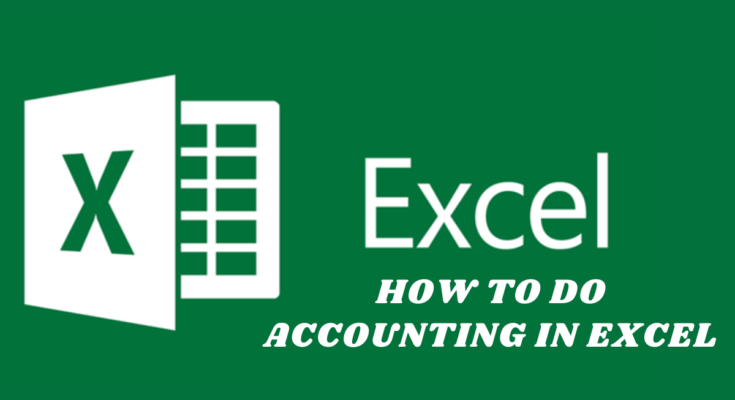Excel is a powerful tool that can be used for various purposes, including accounting. Here are the basic steps to get started with accounting in Excel:
I. Open Excel and create a new spreadsheet: To create a new spreadsheet, open Excel and click on “File” in the top left corner, then select “New” and choose “Blank Workbook.”
II. Set up the spreadsheet: Set up the spreadsheet to match the layout of your accounting records. This will typically include columns for date, description, debit, credit, and balance. You can also add additional columns as needed.
III. Enter your accounting transactions: Enter each transaction into the spreadsheet in the appropriate columns. Be sure to use the correct formula for calculating balances.
IV. Create formulas for calculating balances: Use Excel formulas to automatically calculate balances for each transaction. For example, you can use the formula “=sum(debit – credit)” to calculate the balance for each transaction.
V. Add formatting: Add formatting to the spreadsheet to make it easier to read and navigate. This may include bolding headings, shading cells, and adding borders.
VI. Create reports: Use Excel’s built-in reporting features to create financial statements such as balance sheets, income statements, and cash flow statements.
VII. Save and backup your work: Save your spreadsheet regularly and make backups to prevent data loss.
These are just the basic steps to get started with accounting in Excel. There are many more advanced techniques you can use to make your accounting processes more efficient and effective.
I. OPEN EXCEL CREATE A NEW SPREADSHEET
Here’s how you can open Excel and create a new spreadsheet:
Click on the Start menu button at the bottom left corner of your screen (on Windows) or launch Finder (on Mac) and go to the Applications folder.
Look for the Microsoft Excel application and click on it to open it.
Once Excel is open, you will see a blank workbook by default. If you want to create a new workbook, click on “File” in the top left corner of the screen, then select “New” and choose “Blank Workbook.”
Alternatively, you can use the shortcut key combination of “Ctrl + N” (Windows) or “Command + N” (Mac) to create a new workbook.
Now you should have a new Excel spreadsheet open and ready to use!
II. SET UP THE SPREADSHEET
Here’s how you can set up the spreadsheet in Excel:
Start by naming your spreadsheet. You can do this by clicking on the text “Book1” or “Book2” in the top left corner and typing in a name that describes the content of your spreadsheet.
Next, you’ll want to add headers for each column in your spreadsheet. Common headers for an accounting spreadsheet include “Date,” “Description,” “Debit,” “Credit,” and “Balance.” You can add headers by typing the text into the first row of the spreadsheet.
Adjust the column width by selecting a column and then dragging its border to the desired size. You can also use the “Format” menu to adjust the width of the column or to apply a specific format to the text, such as bold or italic.
To make it easier to read and understand the data, consider adding some formatting to the spreadsheet. For example, you can use shading or borders to separate different sections of the spreadsheet.
If you plan on using a lot of data in your spreadsheet, you may also want to consider freezing the top row so that it remains visible as you scroll through the spreadsheet. You can do this by selecting the second row of your spreadsheet and then clicking on “View” in the top menu. Then select “Freeze Panes” and choose “Freeze Top Row.”
These are just some basic steps to set up a spreadsheet in Excel. Depending on the purpose of your spreadsheet, you may need to add additional columns or formatting to meet your specific needs.
III. ENTER YOUR ACCOUNTING TRANSACTIONS
here’s how you can enter accounting transactions in Excel:
Start by selecting the cell where you want to enter your first transaction. Typically, the first transaction will be entered in row 2, since row 1 is reserved for headers.
Enter the date of the transaction in the “Date” column. You can do this by typing the date directly into the cell, or by using the date picker tool that appears when you click on the cell.
Enter a description of the transaction in the “Description” column. This could be a brief summary of what the transaction was for.
Enter the amount of the transaction in either the “Debit” or “Credit” column, depending on whether the transaction represents money going out of your account or coming in. If the transaction is a debit, enter the amount in the “Debit” column, and if it’s a credit, enter the amount in the “Credit” column.
Repeat this process for each transaction you want to record, adding a new row for each transaction.
Once you’ve entered all of your transactions, you can use Excel’s built-in formulas to calculate the balance for each transaction. You can do this by entering a formula in the “Balance” column that subtracts the total debits from the total credits for each transaction.
That’s it! With these steps, you should be able to enter your accounting transactions in Excel.
IV. CREATE FORMULAS FOR CALCULATING BALANCES
here’s how you can create formulas for calculating balances in Excel:
Select the cell where you want to calculate the balance for the first transaction.
Enter a formula that subtracts the total debits from the total credits for that transaction. The formula should be entered in the “Balance” column for each transaction. For example, if you have a debit of $100 and a credit of $50 for the first transaction, you would enter the formula “=$100-$50” in the “Balance” column.
Excel allows you to use relative cell references in formulas, which means that you can copy the formula to other cells and Excel will automatically adjust the formula to use the correct cell references. To do this, click on the cell with the formula and then drag the fill handle (a small square in the bottom right corner of the cell) to the right to fill in the formula for the other transactions.
Excel also allows you to use absolute cell references in formulas, which means that a cell reference will always refer to the same cell, even when the formula is copied to other cells. To do this, add a dollar sign ($) before the row and column references in the formula. For example, if the total debits for the entire sheet are in cell B2 and the total credits are in cell C2, you would use the formula “=$B$2-$C$2” in the “Balance” column.
Once you have entered the formulas for each transaction, Excel will automatically calculate the balance for each transaction.
That’s it! By following these steps, you should now have formulas in place for calculating the balance for each transaction in your accounting spreadsheet.
V. ADD FORMATTING
Here’s how you can add formatting to your accounting spreadsheet in Excel:
Select the cell, range of cells, or entire column that you want to format. You can do this by clicking and dragging over the cells or by clicking on the column header to select the entire column.
Once you have selected the cells, you can use the “Format” menu in the top ribbon to apply different formatting options. For example, you can change the font size or color, add borders, or apply shading to the cells.
To apply shading to a cell or range of cells, click on the “Fill Color” button in the “Home” tab and select a color from the dropdown menu. You can also use the “Conditional Formatting” option to apply shading based on specific criteria, such as values greater than a certain number.
To add borders to a cell or range of cells, click on the “Borders” button in the “Home” tab and select a border style from the dropdown menu. You can choose to add borders to the outside of the cell or to specific sides of the cell.
To change the font size or style, select the cells you want to format and click on the “Font” dropdown menu in the “Home” tab. From here, you can choose a different font, adjust the size, and apply bold or italic formatting.
You can also use the “Conditional Formatting” option to highlight specific cells or ranges of cells based on certain criteria. For example, you can use conditional formatting to highlight transactions that exceed a certain amount or to highlight cells with negative values.
These are just a few examples of how you can add formatting to your accounting spreadsheet in Excel. By using these formatting options, you can make your spreadsheet more readable and visually appealing.
VI. CREATE REPORTS
Here’s how you can create reports in Excel based on the data you have entered in your accounting spreadsheet:
Start by selecting the cells or range of cells that you want to include in your report. This could be all of the cells in your accounting spreadsheet, or just a specific range of cells that contain the data you want to report on.
Once you have selected the cells, you can use the “PivotTable” feature in Excel to create a report. To do this, click on the “Insert” tab in the top ribbon and then click on the “PivotTable” button.
In the “Create PivotTable” dialog box, select the cells or range of cells you want to use as the data source for your report. You can also choose where you want to place the PivotTable (on a new sheet or on the same sheet as the data) and customize the layout of the PivotTable.
Once you have created the PivotTable, you can use the “Fields” pane to add fields to the report. For example, you could add the “Date” field to the “Rows” area and the “Debit” and “Credit” fields to the “Values” area to see a summary of all transactions by date.
You can also use the “Filter” pane to filter the data displayed in the report based on specific criteria. For example, you could filter the report to show only transactions for a specific account or time period.
Once you have created your report, you can use Excel’s formatting options to customize the appearance of the report. For example, you can adjust the font size and color, add shading to specific cells or ranges, and add borders to the report.
These are just a few examples of how you can create reports in Excel based on the data in your accounting spreadsheet. By using the PivotTable feature and other Excel tools, you can easily analyze and present your accounting data in a clear and organized format.
VII. SAVE AND BACKUP YOUR WORK
Saving and backing up your work is an important step in any project, including an accounting spreadsheet. Here are some tips on how to save and backup your Excel accounting spreadsheet:
Save your work frequently: Excel allows you to save your spreadsheet in a variety of formats, including .xlsx, .csv, and .pdf. To save your work, click on the “File” tab in the top ribbon and then click on “Save” or “Save As” to save a new copy of the file. It’s a good idea to save your work frequently, especially if you have made significant changes to the spreadsheet.
Use cloud storage: One way to backup your work is to use cloud storage services like Google Drive or Microsoft OneDrive. These services allow you to save your Excel file to a remote server, so that you can access it from anywhere with an internet connection. They also provide automatic backups, so you can recover your work in case of a computer failure or other issue.
Use external storage: Another way to backup your Excel file is to save it to an external storage device like a USB flash drive or an external hard drive. This way, you can keep a physical copy of your work in case of a computer failure or other issue. It’s a good idea to make regular backups and keep them in a safe location.
Use version control: Some cloud storage services, like Google Drive, provide version control features that allow you to track changes to your file and restore previous versions if needed. This can be a useful tool if you need to revert to an earlier version of your accounting spreadsheet.
By following these tips, you can ensure that your accounting spreadsheet is saved and backed up properly, so that you can access it when you need it and protect it from loss or damage.



